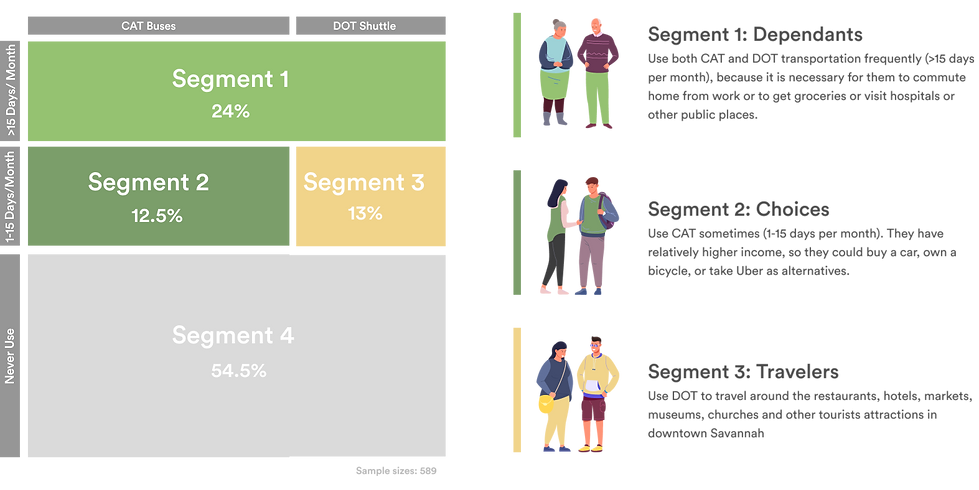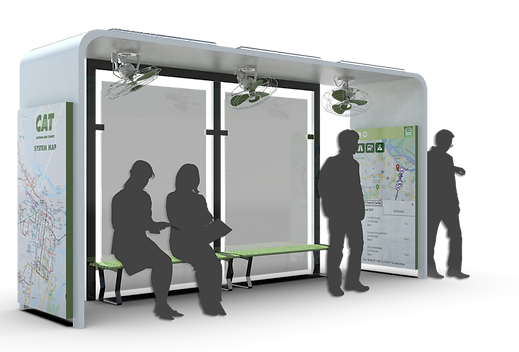
Sustainable Public Transportation Service System
CHALLENGE
As a tourist town, the public transportation service system plays a big role in the Savannah community. In recent years, the sharply declining transit ridership and low performance show that the current public transportation does not play well for the Savannah community. The big systematic problem that needs to be solved is how can we help the current public transit system improve and design a sustainable public transportation service for the local community.
DURATION
Jan- March, 2023
MY ROLE
Service Designer
Design Researcher
MY RESPONSIBILITIES
System Mapping
Auto-ethnography Research
Contextual Interview
DELIVERABLES
In order to provide innovative insights and service system solutions, this project focused on developing internal and external processes and system enhancements with stakeholders based on Savannah’s current public transportation system. Solutions were based on systems improvement, analysis, observation, and interaction.
TEAM
Liuyun Hu
Siyun Lu
Chongyuan Yin
Imani Morgan
BACKGROUND
The ridership for CAT, as the mainstream public transit in the Savannah community, was relatively consistent leading up to 2019 across all modes. In FY 2019, CAT carried 3,168,774 passengers on the fixed-route network, 112,915 on CAT Mobility, and 787,468 on the Savannah Belles Ferry. A sharp decline in ridership in Spring 2020 (see Figure 5). Ridership decreased by 21% in March 2020, and then again by 71% in April 2020. Ridership increased over the summer of 2020 and has remained mostly stable since. Overall, however, annual ridership for FY 2022 was only 42% of FY 2019. Not only CAT, but the current public transit system (DOT, Ferry) is quite concerning and not accessible enough for the Savannah community.
The data shows Chatham County is still heavily car-dependent, which is disproportionately harming low-income and minority communities. The need for transportation equity and accessible public transportation is crucial.

From a systematic innovation perspective, how can we develop a sustainable public transportation system that better serves the Savannah community?
1
What challenges are people in the Savannah community facing in micro-level customer experiences?
2
How can we improve the current public transportation experiences?
3
How can we envision a futuristic and sustainable public transportation service system?
4
From the macro level, how can we improve the ecosystem and infrastructure of the public transportation service system?
Research
From understanding customer experience to system level, the service design methods and value exchanged have been analyzed and shown.

Click to enlarge the image👆
01
Understanding Competitors
What is our current service?
Understanding what the current public transportation services are.

Chatham Area Transit Bus Services (CAT)
CAT focus on
• Residential density
• Job density
• Activity density
• Density of low-income residents

The fare-free downtown transportation system (DOT)
The DOT routes are designed for trips only within the historic district. They are designed to be useful to tourists, travelers, people who work downtown, and people who live downtown. They are not expected to be useful for longer trips, into and out of downtown or across the city or county. The City’s DOT routes are an example of a more specialized service In their case, they are specialized for short trips within downtown.
02
Understanding Customer Experience
Who is using the current service?

Customer Research
We conducted primary research and secondary research to understand our current customer and users better and their experience.

Customer Experience Survey
19 surveys were collected in total and marked with numbers near the bus stop.

Autoethnography
Observed and recorded the experience of Savannah public transit service and mapped the process.


In-depth Interview
Interviewed 5 passengers who use savannah public transit on daily basis.
Public Transit Customer Journey Map
From the customer experience level: Primary and secondary research was conducted around our passengers' current ridership journey. This is what we discovered.

CAT Public Transit Customer Journey Map

Click to enlarge the image👆

DOT Public Transit Customer Journey Map

Click to enlarge the image👆
03
Understanding Service Ecosystem
Focus Group
9 participants who ride CAT and dot on a daily basis
Insights & Takeaways:
Improving Micro-Transit:
Expanding jobs, the current service “mobility” does not provide real-time booking
Accessibility:
Blind rider loves the bus system, and stops are announced audibly
Nationwide labor shortage:
Drivers labor resources are the biggest constraints to provide better service
Employees Travel Training:
Industries to pay taxes


Current Service Ecosystem Map
From a systematic perspective, there are three levels micro, meso to macro level. Each reveals how the institution and policy impact the customers.

Click to enlarge the image👆
Problem Statement
There are lots of opportunities that can be improved in the current public transportation system service.
Not Inclusive
-
Not accessible for disabled people
-
Mothers' needs not met
-
New users don't know about the digital tracking app
Not user friendly
-
App design is not intuitive and hard to use
-
Unsafe and unclean interiors in the public transit service environment
-
Signage is not visible
Not Reliable
-
Wait time is long
Design Opportunities
From the customer experience level
How might we provide a user-friendly, reliable, and inclusive public transit service for the savannah community?
From the systematic level
How can we develop a sustainable public transportation system that better serves the Savannah community?
Ideation

From customer experience leverage points to the systematic level, we did ideation session to think around these two how might we general questions.
Final Design

Public Transit Digital System Redesign
The redesigned app help improving the customer experience.

Public Transit Functional Space
Redesign bus stop of the public transit to provide savannah community better service.
Future Service Map

BEFORE SERVICE
BEFORE SERVICE
01
Check the schedule and research the bus route, schedule, fares, and other important information online or by phone.

BEFORE SERVICE
1
02
Connect smartphone or contactless card with payment.
03
Find the location of bus stop through clear and obvious bus stop.

DURING SERVICE
04
Arrives at the accessible bus stop and waits for the bus.
05
See exactly where their bus is and when it will arrive at their stop, reducing wait times and increasing the accuracy of schedules.

07
DURING SERVICE

07

DURING SERVICE

07

DURING SERVICE
05
See exactly where their bus is and when it will arrive at their stop, reducing wait times and increasing the accuracy of schedules.
06
The bus arrives, and the customer boards the bus through the front door or rear door if applicable. The customer buys the ticket or scans the pass.
07
Real-time reminders and get off the bus, arrive the destination.

AFTER SERVICE
08
Evaluates their overall experience with the public bus transportation system. The customer may provide feedback to the transit agency or share their experience with friends and family.

Long term opportunities
Increased Investment in Transit Service
The State of the System and Market Analysis confirms the need for investment in transit service. The need for increased investment in transit includes more frequent service, longer hours of service, more service on weekend days (especially Sundays), and an expansion of the service area. Future investments should consider new service delivery models such as microtransit and commuter express to maximize the impact of additional funding.

Passenger Amenities and mobility hubs
There is a need for CAT to strengthen its passenger facilities, especially at locations where lots of riders are using the system and where multiple routes connect. There are also opportunities for mini-hubs (or super stops) and/or mobility hubs to create places where people can transfer between different travel modes, such as parking and bus service, ferry and bus service, or bicycle and transit.

Partnerships
Partnerships with the highest potential in the short-term include other regional transportation service providers, such as the Savannah-Chatham County Public School System and the Coastal Regional Commission (CRC). Build partnership with major employers and institutions and help design and tailor transportation services to specific needs and share the cost of operating these services by forming public private partnerships.
